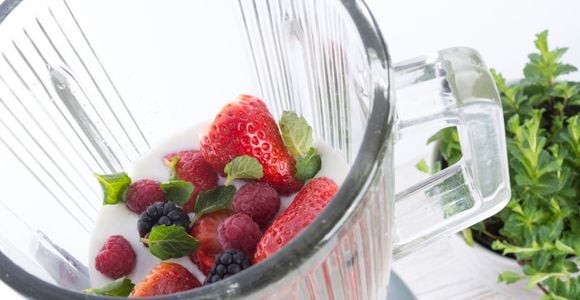One of the most important parts of a healthy eating plan for weight loss is being prepared and planning ahead. A healthy body starts in your kitchen, because weight loss involves making lifelong changes to your eating habits. There are certain key kitchen gadgets that will gear you up for weight loss by helping you prepare easy, delicious healthy meals. Let's take a look at which kitchen gizmos are essential for healthy meals and snacks.
1. A Blender
The mighty blender will ensure that you can whip up healthy meals and snacks in no time. Of course, blenders are your go-to kitchen gadget for protein-packed, fiber-filled smoothies. But think beyond the morning smoothie. With a powerful blender, you can easily create your own nut butters (full of heart-healthy fats, hunger-squelching protein and beneficial minerals), vegetable purees, hummus, soups, whole-grain bread crumbs, pesto, salsas, guacamole and low-calorie frozen drinks. The possibilities are endless!
2. Metal Vegetable Steamer
This cheap, metal kitchen gadget allows you to steam veggies and fish over a pot of boiling water on your stove. You can prepare your vegetables with no added oil, keeping the calorie count low but the nutrient content high (steaming does not cause the loss of water-soluble vitamins that boiling does). An added bonus, this kitchen staple is also a bargain buy. Most cost less than $10.
3. A Sharp Chef's Knife
A high-quality, sharp chef's knife will allow you to slice and dice your way through tons of fruits and veggies in a breeze. Don't bother purchasing a big set of knives in a fancy countertop wooden block. Instead, invest in one really good chef's knife that is about eight to 10 inches long. If cutting up fruits and vegetables can be done quickly and easily, you'll be more likely to eat them.
4. Microplane/Zester
This tool works double-duty. You can use it to finely grate cheeses (it grates such small shreds that you don't end up using very much) and also zest citrus fruits to add low-calorie, intense flavors to your dishes. The zest of lemons, limes and oranges will boost the flavor of your meals as you cut back on fat, salt and sugar, which are often used to provide taste.
5. Oil Mister
Although oils are definitely an integral part of a healthy diet, oftentimes, people end up using much more than is necessary. Remember, a tablespoon of oil contains 120 calories and about 14 grams of fat. With an oil mister, which you fill with whichever oil you prefer, you can lightly coat the bottom of a skillet with a lot less oil -- about 80% less, actually -- than you'd use if you poured it directly from a bottle. It can also be used to lightly spray on a smaller amount of salad dressing.
6. Digital Kitchen Scale
We all know portion control is a key component of weight loss and general healthy eating. Make things easier on yourself with a digital kitchen scale that shows you exactly how much you're taking in.
7. Small Plates
Most kitchen plates have grown to about 12 inches, up from the normal 9-inch plates from decades ago. Portion control is easy when you purchase more reasonable 9-inch plates (what is now called a "salad plate") and use them as your dinner plates.
8. Slow Cooker
This old standby does more than cook up the perfect beef roast. It's great for cooking up a big batch of beans, whole-grains, soups and stews, and of course, one-pot meals, such as chicken and roasted vegetables. It's perfect for healthy eaters who don't have a ton of free time to devote to meal prep.
Kari Hartel, RD, LD is a Registered, Licensed Dietitian and freelance writer based out of St. Louis, MO. Kari is passionate about nutrition education and the prevention of chronic disease through a healthy diet and active lifestyle. Kari holds a Bachelor of Science in Dietetics from Southeast Missouri State University and is committed to helping people lead healthy lives. She completed a yearlong dietetic internship at OSF St. Francis Medical Center in Peoria, IL, where she worked with a multitude of clients and patients with complicated diagnoses. She planned, marketed, and implemented nutrition education programs and cooking demonstrations for the general public as well as for special populations, including patients with cancer, heart disease, diabetes, Alzheimer's disease, obesity, and school-aged children.




